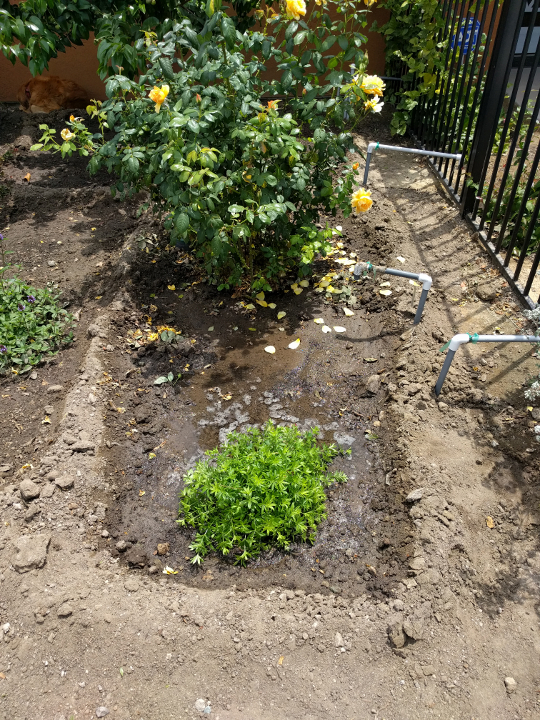Thanks, I’ll look the rosemary up. Natives are a great first choice. The catmint/catnip I have was wild on a Great Grandparents’ homestead. It probably escaped a flower bed many years ago. The bloom is just greeenish-grey, very fragrant with a lower, compact mound shape.
I’ve found they prefer the curly here, which I find insipid and tasteless. I’ve seen caterpillars on lovage too. Though I can’t imagine how many it would take to devour my plant.
Scott
IL847, around here we have these smaller, Downy Woodpeckers that are friendly and will do anything to get a drink from the hummingbird feeder.
Thanks @Antmary for your suggestions 
Sedums – I don’t care for them at all.
Hyssops – from the Lamiaceae family I only have room for a few; e.g., Cretian Calamint.
Ice plant – both a fire hazard and a rat haven here.
Snow-in-summer – a beautiful plant.
Rudbeckia – from the sunflower family. I am cautious about flowers that can become weeds in my orchard basins 
Garlic chives – My vegetable and herb beds include members of this genera.
Irises – growing them next to my roses.
Verbena – I grow a species of it as an herb.
Poppies – They are seeded enmass along California roads and highways.
Tulips – I’m not a fan.
Keep in mind that the plants I mentioned in the first post of this thread are just a fraction of the species I’ll be planting out this year. 
I thought ice plant was encouraged as a fire protecting plant?
I can’t imagine trying to get it to light on fire. Well, maybe if it died and dried. Personally I’ve killed it three times, my limit, as my soil seems too water retentive and the plant just melts away in autumn, never to return.
Scott
Though they are horribly invasive, trumpet vines are also good for attracting humming birds.
Overtime ice plant builds up dry mats underneath the current growth. In ten years time in my climate these can be 5-10" thick. When it catches on fire in a Santa Ana wind storm the patch acts as a flame thrower.
Also as I mentioned, the mats are a haven for rodents - esp. rats.
I’m growing Passion Fruit “Frederick” instead.
I like them myself. More bees come to my one sedum than anything else, like hundreds of them. Never seen anything like it. It requires no care at all. I do usually cut the flower stalks back when they first appear as the next round has shorter stems and the flowers don’t fall over.
In my area they promote the planting of milkweed to facilitate the Monarch butterfly migration to Mexico. Looks like the milkweed drive is having some success too. Evidently it’s more or less essential.
I’m very lucky to live on an extremely diverse property with 60 acres of timber, a few acres of pasture, a few of alfalfa and a few of vege and perennial flower gardens (my MIL sold organic veges and bouquets at market some years ago). All this the middle of a corn and bean desert makes the place a real oasis. I have a special fondness for the Lamiaceae family (as do my bees) so am always adding to the list. Mints, Catmint, Lemon Balm, Salvias, Russian Sage, Rosemary, Hyssop, Bee Balm, Lavender, Savory, Lions Ear, Thymes and my personal favorite Agastache (Anise Hyssop or Hummingbird Mint). I’m growing a half dozen different varieties of Agastache and love their presence, long bloom time (3 mos) and the native species makes my and my daughters’ favorite herbal tea.
I like to bring that diversity right on into the orchard. It is not fully planted out yet, but my goal is to promote diversity and ecosystem function (to minimize pest and disease issues). In addition to about 50 semi-dwarf trees, I interplanted a variety of fruiting shrubs, herbs and flowers (including currants, gooseberries, raspberries, blackberries, honeyberries, aronia, sage, oregano, thymes, rosemary, dill, lovage, fennel, chives, garlic chives, garlic, bunching onion, agastaches, daylilies, rhubarb, milkweed, echinaceas, yarrow, comfrey, calendula, lots more). I also planted a small windbreak on 3 sides consisting of mostly edible shrubs (including hazelnuts, juneberries, wild plum, cornelian cherries, nanking cherries, elderberry, aronia, seaberry, rugosa rose, lilac, siberian pea shrub, etc). Its not much to look at yet but I’m excited to see it evolve and come to fruition!
I really like the picture on the background of your profile. This is the real butterfly garden.
Female flowers on a fruiting banana 
Today I installed BG3 
Biden’s Beedance “Red stripe”
Yarrow Achillea millefolium “Paprika”
Egyptian star-cluster Pentas lanceolata “Deep Rose”
Today I installed BG2 around the buried stump where I’d previously planned to put a Eureka Lemon tree  . Here’s what went in the ground:
. Here’s what went in the ground:
Leonotis ocymifolia
Canary Island Sage (Salvia canariensis)
Cleveland Sage (Salvia clevelandii)
Sage “Holt’s Mammoth” (Salvia officinalis)
Sweet Lavender (Lavandula x heterophylla)
Silky Yellow Milkweed (Asclepias curassavica)
You should include a Lavender (Intermedia) the best!
Is there a reason you dont mulch your plants to preserve water?
My understanding is that the hybrid Lavandula x intermedia is widely grown as a floral and extract crop. However, it is not so much of a bloomer here as in latitudes to the north. I have better luck with Sweet Lavender (Lavandula x heterophylla) and French Lavender (Lavandula dentata).
I buy mulch by the truckload  . I’ll be replenishing with about 30 cu.yds. in July.
. I’ll be replenishing with about 30 cu.yds. in July.
Sweet Woodruff loves shade.
Yes. This one has been been in a 2 gallon pot with partial shade of about the same percentage it will receive here. We’ll see what happens!
To the left of it is Self Heal (Prunella vulgaris).



